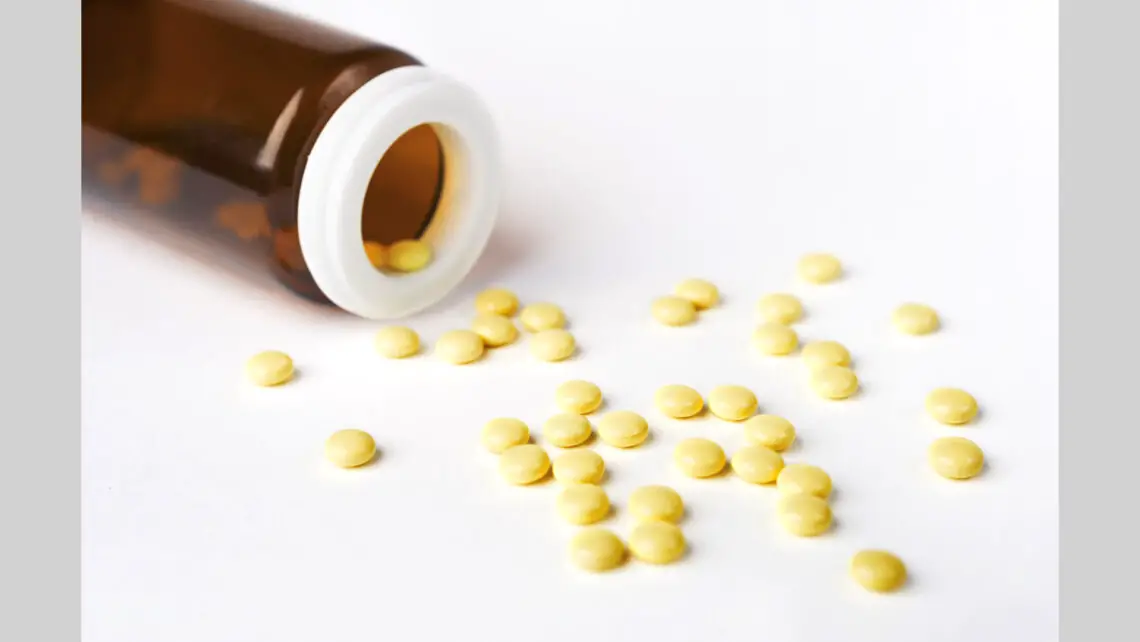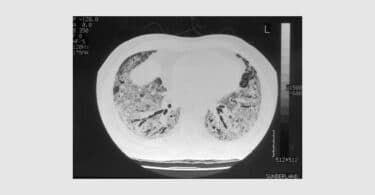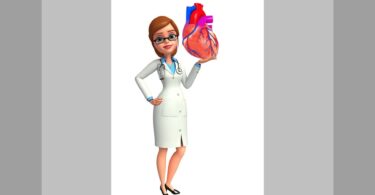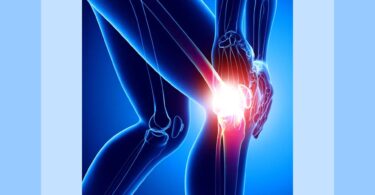We are in the 90s. It is about a young mother of 28 years who had an extremely premature birth about two years before the start of treatment (27th week of pregnancy, 750 g) and whose child Tim now suffers from tetraplegia (all four limbs spastically paralyzed), epileptic seizures and so-called microcephaly (abnormal smallness of the head due to primary maldevelopment of the brain and premature closure of the cranial sutures), i.e. is physically and mentally severely disabled.
One year before the pregnancy with Timmy, the young woman had an abortion. She probably had a tendency to miscarry because she had recently been pregnant again, and profuse bleeding after lifting too heavy a load had caused her to abort
Extreme premature birth – Tim
But also, Timmy’s pregnancy was full of complications from the very beginning. For a long time, almost from the beginning, there was a pulling pain in the abdomen, “as if the menses were about to start”, so that the patient was written off sick and had to lie down for three months. Furthermore, from the first to the third gestation month there was always slight spotting of brownish color, so she was given magnesium.
From the 4th month of pregnancy, the expectant mother was allowed to return to work, but she had to continue to take care of herself. One month later, there was another light bleeding; however, the doctors found no cause; the cervix was also still closed.
A little later, it appeared that amniotic fluid had been lost; however, the attending gynecologist diagnosed only discharge and prescribed a Döderlein preparation. In the 7th month of pregnancy, to her great dismay, the young woman lost amniotic fluid again, this time significantly increased, so she was transferred to the hospital for inpatient monitoring. Again, a magnesium supplement was given to prevent any contractions that might occur. However, increased labor-like contractions still occurred. As a result, absolute bed rest was prescribed.
Despite all medical efforts and 10 days of strict lying down, a premature “rupture of the amniotic sac” could not be avoided, so that now heavy labor-inhibiting drugs had to be taken, including cortisone for the lung maturation of the still unborn child. The patient had “badly tolerated” this and so a severe urinary tract infection occurred during pregnancy (the young woman had been very bladder sensitive all her life!), which was treated in the conventional manner with antibiotics.
Finally, the contractions stopped and the infection “was under control”, only – the heart tones of the child suddenly left much to be desired! This was especially noticeable during urination, where almost a cardiac arrest of the still unborn child could be observed, due to the “pressure and pushing of the mother”.
Another conspicuous feature was the “perpetual gulping of the child in utero”. Finally, in the 27th week of gestation, the doctors abruptly presented the heavily pregnant woman with the macabre alternative of “letting the child die in the womb or performing an immediate Caesarean section, which, however, was to be judged as extremely questionable with regard to the child’s viability and health”. Within only 10 minutes, the young woman had to decide! And she, together with her husband, decided to have their child.
So it came to the Caesarean section and an extreme premature birth with all the dangers lurking through the conventional neonatological intensive care. Timmy was intubated (artificially ventilated) for thirty days pretty much immediately after birth. During the emergency C-section itself, there was a respiratory arrest for a few seconds, so the little one had to be resuscitated.
Then, on the second day of life complication by a so-called “brain hemorrhage” (grade 3-4!). Later Timmy received four blood transfusions “because of the constant examinations and insufficient blood formation”. Thrombosis due to his lacerated left arm from so many venous accesses over time.
Six weeks in an incubator. Umbilical hernia and inguinal hernia on the right. Epileptic seizures. Focal convulsions. Absence epilepsy. Problems with the swallowing reflex, although it was really very well developed in the first days of life! Talipes equinus. At about one year of age pneumonia, treated with antibiotics. Tendency to infection and much more.
Of course, Timmy has received vaccinations from the beginning according to the valid vaccination schedule. Meanwhile, the little boy is severely disabled (tetraplegia, epileptic seizures, absences)! He can neither sit independently, let alone turn in his crib independently nor hold his head upright for a longer period of time and is therefore constantly dependent on help.
The young mother
Due to the good experiences and progress with homeopathy with her son Tim, the young mother herself now came for chronic treatment. She was primarily concerned with her recurrent bladder infections and “problems with the lower abdomen”, not with another pregnancy. This was completely out of the question for her, she would have lost all courage for this.
The idea that she might have to take care of two disabled children for the rest of her life made her uncomfortable and frightened. It was already hard enough with one, and no one could get a realistic picture of it without having experienced it firsthand.
Because of an existing acute cystitis and the fact that all previous bladder infections and other diseases had almost been treated with antibiotics without exception, and because of the connections from Tim’s known family history, we finally started ad hoc with Sulfur LM18, 3 drops on a teaspoonful of water, as needed.
That is, as long as she was well again, she was not to take anything else; only when the next recurrence announced itself again, was to continue with the Sulfur. And this until the questionnaire for the anti-miasmatic chronic cure (approx. 30 pages, half-page description) had been filled out and the detailed anamnesis interview had been conducted, in order to determine a final chronic remedy for the overall circumstances.
A good four months later, the detailed initial medical history could be taken. She had coped well with Sulfur; since that time she had had significantly fewer problems with her bladder. Previously, especially between the ages of 21 and 22, the bladder infections had risen monthly!
It was only in the last three years that they became less frequent (about three to four times a year), but she had drunk extremely heavily at the slightest irritation and was thus often able to prevent acute cystitis. She had her first urinary tract infection as a child, at the tender age of about four. Her left kidney was said to be crippled or in a “different position, possibly horizontal”; in any case it worked more slowly. This was determined a few years ago by means of an examination with radioactive contastant, to which she had reacted with a fainting fit.
At present, she picked up every infection from Tim and was often dull, her neck was tense and she suffered from headaches, sore throats, coughs and colds. In the past, there were constant infections, or “a permanent infection”, as she called it. However, she rarely had a fever; she could not even remember a real fever.
Furthermore, there was a tendency to genital fungal infections with vaginal discharge, usually lumpy, gritty and beige-yellowish. There was also a rather strong odor after menstruation: sometimes like old yogurt and sometimes more or less intensely fishy. The menses themselves were quite inconspicuous in terms of pain and intensity.
In the past, however, they were accompanied by severe abdominal pain and cramps, back pain and very heavy bleeding. They also always lasted much longer than seven days. Even today, the color of the blood was still quite dark, sometimes even blackish. One week before menstruation, the patient was always extremely moody and restless. She had taken the pill for about 10 years and tolerated it relatively well.
In the area of the chin there were always skin rashes in the form of pimples and pustules, which were painful even in the wind. There were also small “zits” around the nose, especially after eating citrus fruits. She had been reacting to grasses for years with the mucous membranes of the upper respiratory tract.
She suffered from hay fever continuously from May to about September. A desensitization had not brought the desired success. Furthermore, there was a local allergy to mascara and earrings. With costume jewelry, her earlobe piercings became inflamed after only half an hour, and this was also the case with clips. Sham jewellery on the neck made reactions similar to those of sun allergy. The tip of the nose was more often moist and cold, like that of a dog.
In the past, tonsillitis was frequent until the tonsils were removed along with the adenoids at the age of ten. In the wake then unspecific sore throats and anginas of the salpingopalatine fold. In addition, the young mother suffered almost constantly from an extended flatulence.
Her favorite taste was sour. Her hands and feet were often cold. She also froze quite quickly on the whole. Furthermore, there was a slight tendency to varicose veins. When it was hot, her feet would regularly swell. At night they would get so hot that she would stretch them out from under the covers. There were white spots on her nails from time to time. The tongue impressed with a white coating.
Until recently, there were massive fears of diseases, especially AIDS, cancer and herpes. She always immediately assumed the worst; for example, when she had a bladder infection, she had the idea of a possible bladder carcinoma. The usual vaccinations were given, including the smallpox vaccination.
The parents of the young woman had been divorced for some time. Her father, a foreigner from another culture, had “bullied” her a lot in her childhood (locked her up, forced her to do housework, etc.), sometimes brutally beating her and often threatening her with a knife; once he even put a knife to her lower jaw for several minutes to force her to obey him. Later, when she had left home, he had often chased her and intimidated her. – Her mother was German; there was a very intimate, cordial relationship with her.
The main connections from the family anamnesis are especially a gonorrhea on the part of the patient’s father and a tuberculosis on the part of the patient’s maternal grandmother, with which it becomes clear at this point at the latest that all miasms were strongly represented! Furthermore, on the mother’s side there were menstrual complaints, rheumatic complaints, allergies, hyperactivity and hay fever. On the father’s side, typhoid fever, gastric ulcers, chronic prostatitis, kidney stones, “paranoid dispositions”, “depressive and psychopathic tendencies” are to be mentioned.
With the common children, the siblings of the young mother, we found long-standing bed-wetting, pneumonia, spermatic cord infections, shingles, fainting fits and hebephrenia (form of a schizophrenia beginning in puberty).
All in all, the most severe miasmatic disorders!
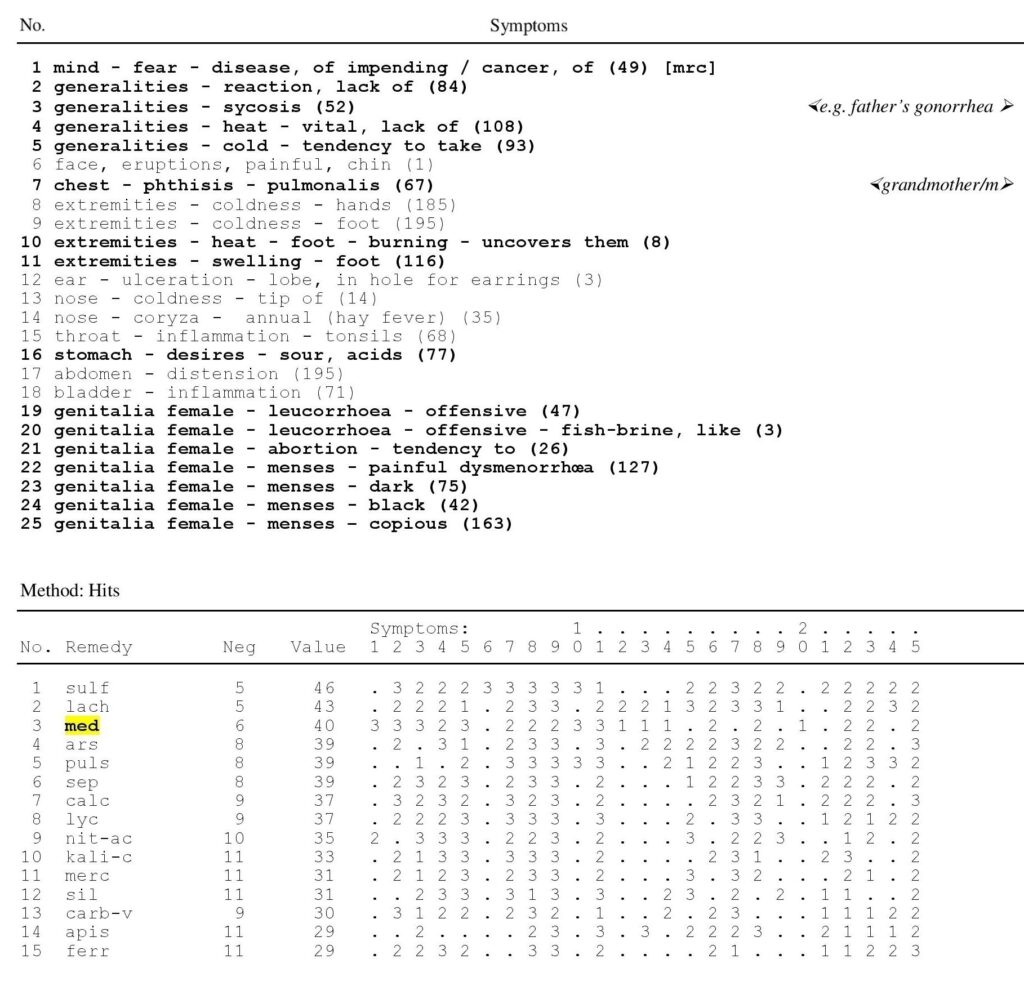
Remedy choice: Medorrhinum LM18, 5 drops to a glass of water, stir vigorously, take only 1 teaspoonful of this, every 3 days in the evening; succuss vial 10 times before use.
Course: The first call came barely four weeks later. The patient suffered from a pronounced irritable bladder and had to go to the toilet constantly. However, the urine test was negative. The doctor had “only” diagnosed a mild ovarian inflammation on the left. The patient noticed this especially when walking.
For the past week, there had also been an increased discharge, whitish, creamy, flaky and without any noticeable odor or itching. In addition, she had great problems with the skin. The rash on her chin had started to blossom enormously, especially after her last menstruation. She had taken Medorrhinum only twice.
We agreed to take the remedy regularly, at first even every two days, so to speak as an acute remedy for the mild oophoritis and to give the chronic healing process “a little boost”, so to speak. Since her vacation was imminent and she wanted to go to the mountains with her family, I ordered Lachesis LM6 just in case, to avoid later procurement problems.
Then, a week later, there was “slight breast irritation” and “slight swelling of the nipples” as well as increased sensitivity to touch of the same, “as if I were pregnant”. We temporarily decreased the number of drops to two and changed the frequency of intake to every three days.
About two weeks later, the ovarian inflammation came back vehemently. First on the left, then moving to the right. In addition, a “biting sensation in the bladder and uterine area”. The nipples were still sensitive, but the swelling had disappeared. The skin had also progressed. However, there was apparently no pregnancy.
We discontinued Medorrhinum and continued to treat the altered acute situation with Lachesis LM6 (5 drops to a glass of water, stir vigorously, taking only a single sip of it as needed; succuss vial 10 times before use.). This had to be maintained for about a week, because every time she tried to reduce the Lachesis dosage a little, the original symptoms kept reappearing. But now she got rid of the sensations for a few days and felt no more pain. Furthermore, a discharge of whitish color and thick flaky consistency had reappeared, smelling slightly sour. We discontinued Lachesis and carried on with Medorrhinum gradually.
Barely three months later, the young woman reported to me that she felt very well and was very satisfied. At present, she took 3 drops (water glass method) about every week and a half. Each time after taking it, she felt a slight tension and swelling in her chest and a slight pain (“pain is too much to say; it’s a kind of awareness”) in her abdomen, which always ended with a little discharge. – We agreed on a remedy break of about three weeks and a new appointment to discuss the previous chronic cure.
Under Medorrhinum, her “period” was heavier; since stopping the remedy, it has been normally heavy. During her menstruation she was now very well. The bleeding itself lasted five days, the first two days somewhat darker and then nice and light and “fresh”. Since the end of Medorrhinum, after “her time of the month”, slight pain had slowly returned to the left ovary; also to the right, but there only subliminally.
Her breast reacted only very weakly, and her acne in the chin area had also improved considerably. Vaginal discharge was present all the time, slightly yellowish and smelling a bit sour. However, the flatulence has disappeared completely. In the evening, there was swelling of the feet and heavy legs; the feet also became hot, so that she had to stretch them out of bed.
Her dreams were also very striking at the moment. She increasingly dreamed of feces, of “digging in the shit”. Her fingernails had become very beautiful and she is no longer cold. Her fears, especially of illness, were now definitely a thing of the past. And there was no longer any question of a tendency to catch colds.
The young woman was overjoyed, especially with regard to the progress of her little Tim, who at this point no longer needed to take any antiepileptic drugs and had become much more lively and aware with homeopathy. We had weaned off three antiepileptics over a nine-month period; two months of weaning off each and one month of waiting for withdrawal symptoms! “You have changed our lives and we are happy about it”, both, mother and father said. – A very weighty statement that also makes a therapist happy and encourages him to continue purposefully on the path he has chosen.
We changed the chronic, ant-miasmatic remedy to Lachesis LM18 for 6 weeks at first, 3 drops to a glass of water, stir vigorously, take only 1 teaspoonful of it, twice a week in the evening (succuss vial 10 times before use).
About eight weeks later, the patient reported her hay fever, which had existed for only one week (after all, we already had mid-June!), “often also with rain”, the acute peaks of which she should henceforth coup with Allium cepa 12X. With regard to the ovaries, there was once a throbbing on the left, four days later on the right, but without pain.
During the middle of her cycle, both ovaries were palpable with movement. Furthermore, the young woman quickly got heavy legs and a pulling sensation in the lower back. She was quickly dull and tired a lot. In addition, she was a little depressed, with no drive. Her breast was painful to the touch; however, since her last menstruation, this was without findings. “On the whole, I am more irritable and impatient.” Her dreams had improved (no longer of feces), but her skin had become more agitated again.
Lachesis was now discontinued and Medorrhinum passed on, but in the potency LM30, 1 drop to a glass of water, only once a week, for an initial eight weeks.
It was not until about four months later that the patient contacted me again. She had taken the LM30 until the beginning of her vacation (for about seven weeks) and was now pregnant. At the moment she was doing quite well. There was no more swelling of the feet, but she was cold again quite quickly.
She also had to urinate quite often again, only small amounts. The vaginal discharge was also still there, still whitish-yellowish; “if it smells at all, it is sourish”. Otherwise, her breast had reacted under Medorrhinum LM30, and there had also been slight ovarian pain now and then.
We reduced the potency back to LM18 at 3-daily intake of only 3 drops by the water glass method for 3 weeks initially.
At the end of this period, the newly pregnant woman still felt very well. She had vomited only once, otherwise there was only rarely a barely noticeable nausea. Also only once there was a brownish discharge for quite a short time, possibly with a little blood. Before that, however, she had been very hurried during a walk.
The other discharge was still yellowish and now and then viscous and had increased since the beginning of the pregnancy. However, the doctor had not been able to detect any fungi. Now and then there was a pulling in the abdomen, but this did not cause her any worries. The freezing had also become much better. Her legs were still warm and heavy and the bladder irritation with the urge to go to the toilet persisted. – Medorrhinum was maintained.
Three weeks later, there was a mild cold with headache and a little sniffles. For two days, minimal spotting, brownish, dark and friable. “Discharge increases with blood, but not much.” Still sour smelling. At end of urination and “in between” a pulling pain toward ovaries. Downward pressure in some circumstances. – We agreed to have the symptoms clarified gynecologically. However, the doctor could not find anything pathological and said that “this was due to physical exertion”.
And our young mother certainly had that, because one does not really get a picture of what it means to live with a handicapped child! The doctor also stated that the placenta was on top, which was not the case with Tim at that time, because it was always very lateral and clearly deep (placenta praevia)! One day after the visit to the gynecologist, the symptoms disappeared – without any treatment – as if nothing had happened. – We were satisfied.
In the following days, there was only occasionally still a slight downward pressure on the cervix when standing, and this in the 4th month of pregnancy, which at this stage – mechanically – could not be plausibly explained. “At night here and there also a pulling and tugging.” – For this reason we intermediately continued treatment with Sepia LM18, 3 drops to a glass of water, every 3 days.
After only one week, the relieving interim report: Things were going very well, she had only taken Sepia twice. Tim’s father then confirmed by telephone: “My wife’s current pregnancy reassures me. The first one was already very problematic at that stage. I am confident and calm.”
Then, in the 15th month of pregnancy, there was hardening of the abdomen more often. “I don’t feel like it’s a contraction, though.” Sometimes only in certain places, “but not rock hard”. For ten minutes or so, sometimes for just a minute. Currently, every morning. The pressure on the cervix had completely disappeared and spotting had not reappeared since then. The discharge, however, continued unchanged. –
We continued the treatment with the original chronic remedy (Med. LM18). In the 22nd week of gestation the next message: It was going very well. No more tension on the abdomen and no more spotting, although she was still lifting her child Timmy. Also no swelling or edema. In the 31st month of pregnancy I received the news: “We’ve already popped the champagne!” It continued to go excellent.
A week later, however, the woman noticed water retention on her legs, especially in the ankle area; not yet visible, but noticeable for a few days. And iron deficiency. She had therefore been taking “Floradix with Iron” recommended by her midwife for some time. With Medorrhinum it only worked about once a week, due to forgetfulness, because there was always so much to do. – We agreed on Levico comp. 3X for the acute iron deficiency, 5 globules 3 times a day as needed, and to increase a little with Medorrhinum (5 drops in a glass of water, every 2 days).
This decision proved to be absolutely right, because with more frequent use, “it got much better with the water”. The dizziness was also gone since Levico. Now and then there was still a little itching of the skin in the evening, but actually this had already been the case during the entire pregnancy, which had increased somewhat at the moment. However, the hay fever was not there (after all, it was already May again!); there were no signs of allergic reactions in the upper respiratory tract at all! – In the following we discussed the homeopathic childbirth kit (homeopathic labor & post-natal kit) for contingencies – there were only six weeks left until the expected date of birth – and we phased out Medorrhinum at this time.
One week before the birth, the gynecologists at the hospital first diagnosed a fungal infection with itchy odorless vaginal discharge, which was treated with suppositories. The contractions then started relatively on time for the due date and after a while they came at a good three-minute rhythm.
Nevertheless, a healthy boy saw the light of day only by Cesarean section. This time, however, the cesarean scar healed much better than the first time – we had performed the post-operative care with the two remedies Staphisagria and Nux vomica – and the uterus contracted again quickly and very well, supported by Bellis perennis, the daisy.
The state of mind of the happy mother of two was very stable and remained so, so that she could soon resume her extensive daily routine. Worth mentioning with regard to the miasmatic aspects is the observation that at the end of this pregnancy quite a lot of small stemmed soft warts (verrucae filiformes) had appeared on the neck and breast of the young woman, which slowly disappeared successively after the childbirth.
Almost half a year later we were able to continue with the chronic cure again, namely with Medorrhinum LM24, 1 drop every 5 days (water glass method), since some symptoms still clearly spoke for this remedy and since her child also showed more or less pronounced signs of a sycotic infant[1] and thus demanded this remedy, that he received exclusively through the breast milk. –
The young woman’s resuming menses had already become completely unremarkable by this time. “Bright blood always came immediately.” All earlier symptoms of the so-called PMS (PreMenstrual Syndrome) had also completely disappeared. The same applied to the bladder irritations and the tendency to cystitis and ovarian inflammation.
A few months later – she had weaned in the meantime – we changed to Sulfur LM18, 5 drops according to the water glass method, for certain reasons that cannot be explained here. And under Sulfur she became pregnant once again! This time, however, there were hardly any symptoms worth mentioning, in any case, the pregnancy “just ran alongside” and was not taken as “seriously” as the one before, I had the impression. In fact, it proceeded in a biologically normal and natural way, as it should always proceed, so that one need not worry at all. It was quite obvious that the young woman had regained her basic trust in nature.
We accompanied this second “homeopathic” pregnancy temporarily with Sepia LM18, but really only temporarily, since the patient hardly thought about taking Sepia due to her busyness with her household, her two children – one of them severely handicapped (!) – and an upcoming move to a new home of her own, and thus forgot the drops more often than she took them. And this was not a big deal, because the young woman continued to be in excellent health. I did not hear from her again until the child was already born, so well had everything gone!
One can only take one’s hat off to so much courage of this young mother, who went her way all alone – of course with the support and understanding of her beloved husband – and who, after having experienced so much suffering, dared to become pregnant again and to give birth to two healthy children. – Congratulations from the bottom of my heart!
Excerpt from my book
“Klassische Homöopathie für die junge Familie – Kinderwunsch, Schwangerschaftsbegleitung und Geburt, Kleinkindbetreuung, Entwicklungsstörungen und Behinderungen, natürliche Entwicklung“
(=”Classical Homeopathy for the Young Family – Desire to have children, pregnancy support and birth, toddler care, developmental disorders and disabilities, natural development”),
2nd volume, 3rd edition, 2016 (so far only available in German)
Bibliography
- Allen, J. H., The Chronic Miasms, 1921, Reprint Edition 2006, B. Jain Publishers Pvt. Ltd., New Dehli
- Grätz, Joachim-F., Gentle Medicine – The True Causes of Disease, Healing, and Health, 2021, Balboa Press, Bloomington, USA
- ComRep V9.0, Repertorization software, ComRep GmbH, Franz Simbürger, Viecht, Bussardstraße 7, D-84174 Eching, Germany, ( 0049 / 8709 / 16 91, comrep.de
Dr. Joachim-F. Grätz
Oberhausen i. Obb.
Germany
About the Author
See author’s bio below on this thread.
[1] See my book “Gentle Medicine”, chapter 2.9.1 The Sycotic infant by John Henry Allen. – However, not every sycotic infant will receive Medorrhinum, because only the individual symptomatology decides and there is also a variety of other antisycotic remedies!



